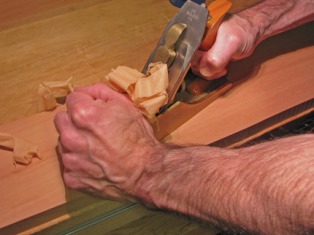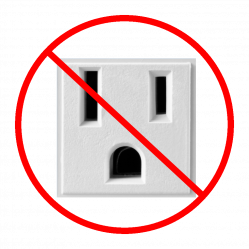Outside the Box
At least I've got that going for me... April 14, 2010
Perspective is a GREAT thing.http://www.pbs.org/woodwrightsshop/video/2600/2607.html
Maybe Ketchup will help...April 12, 2010

With all of the disruptions to my schedule lately, I've not had time to do anything in the shop. Spring break, Easter and everything else have severely put a cramp in my plans for making silky wood shavings. I plan to spend some serious shop time this week breaking through the sharpening barrier, at least with planes and chisels.
With this much to do it's a little like eating an elephant. The only way to do it is one bite at a time. The tasty parts go down easy, but then there's the not so tasty stuff...maybe ketchup will help.
With this much to do it's a little like eating an elephant. The only way to do it is one bite at a time. The tasty parts go down easy, but then there's the not so tasty stuff...maybe ketchup will help.
I'm just really dull...March 19, 2010

Sharpening is a "gateway" skill for hand tool woodworkers. I feel like a calf looking at a new gate. I have ground and re-ground the primary bevel on a plane blade five times this afternoon. One time it's square to the sides but not at the correct angle, the next time its cambered but at the correct angle. I've gone from using expensive jigs to trying it freehand and none of it is working. I've worked on this one blade so long I think I've worn a groove in my diamond stone.
The really frustrating thing is that this is the second Friday in a row I've worked on this blade. I truly am an apprentice without a Master.
The really frustrating thing is that this is the second Friday in a row I've worked on this blade. I truly am an apprentice without a Master.
Galoot Mentality... March 11, 2010

The following is not original. It is from a Fine Woodworking Blog written by Rob Poraco, but it goes a long way towards explaining the thought process of hand tool usage.
The late Tage Frid wrote, in his 1979 book Tage Frid Teaches Woodworking, "I don’t care how it is made - he [the craftsman] can make it with his teeth or a machine - it is still the final product that counts."
Sure, tools and methodology are essentially means to an end. However, the way we accomplish things and the nature of our work life are important too. This is particularly true for the avocational woodworker who is under less production pressure than a full-time professional and thus has the luxury of choice as to how he feels while he is working. In general, I feel better when I’m using my hand tools than when I’m using my power tools, and so there’s one point in favor of hand tools. I also feel good when I see steady progress through the stock preparation phase of a project along with the repeatable precision of machine work, and so score a couple for electricity.
Yet, there’s more to this issue. Hand tool woodworking is a mentality, an approach, almost a philosophy. It does not mean the absence of power machinery. Rather, I believe the hand tool woodworker is one who recognizes that he can impart degrees of quality and personalization to his work with hand tools that are unlikely or impossible with machinery.
This applies to two aspects of woodworking:
The first is methodology. The hand tool worker thinks and plans work differently than those ruled by machines. Processes are incremental. For example, relying only on the table saw to crosscut a drawer front is not likely to produce as excellent a fit as shooting with a hand plane, where fitting can be done in increments of just a couple thousandths of an inch. This level of control builds a relaxed confidence.
Hand tools also allow for error compensation and avoid error build up. For example, in making tenons on the table saw, a machine woodworker is likely to measure stock thickness and assume a sort of perfection, even though the slightest inconsistency in stock thickness can create poor fitting tenons. A hand tool woodworker would work from one reference face of the stock, cancelling small imperfections in stock thickness. If he did use the table saw to make the tenons, he would adjust the machine with a one-sided tolerance, mindful that he can later remove a shaving or two with a plane if necessary to produce an ideal fit. Machines, yes, but on your own terms.
The second aspect of hand tool work has to do with the aesthetics it engenders.Interesting joinery, resplendent surfaces, subtly treated edges, and satisfying contours are some of the distinguishing personalized features we are at ease producing with hand tools. One may use a bandsaw to do most of the work of creating a pleasing contour on a table leg, but a spokeshave and rasps will refine it to a quality that a power sander alone is not likely to achieve. Maybe a round-over router bit gets an edge close to what you want, but a plane gradually alters the mathematically produced edge to something that is less readily definable, but is just what you want. The vision, the work, and the product are personal.
It’s nice to drive to the mountains and even drive through the mountains, but it’s not as nice as hiking them. Power tools drive you there, but hand tools walk you through.
www.rpwoodwork.com/blog
First Steps... March 10, 2010

The first step to getting help with an issue is admitting that you have an issue at all. I have an issue; I'm a galoot.
Dictionaries define galoot in this manner; ga·loot-[guh-loot] nounSlang.an awkward, eccentric, or foolish person.
Woodworkers define galoot another way, but what do we know, we are galoots. In woodworking a galoot, besides being often eccentric and foolish (look at how much we spend on tools), is a term usually reserved for someone that uses hand tools (planes, chisels, saws, etc.) only in their production process.
In these days of Norm Abrams and Home Depot you might ask why anyone would choose to work only with hand tools and elbow grease when they could plug in their Powermatic or Delta and get the job done quickly and efficiently (more on that later). I mean aren't we living in the 21st century for Pete's sake. I, like many other woodworking hobbyists, owned about every power tool you could imagine. Notice I said "owned."
Recently, I made the decision to sell my power tools and go galoot. No, really. It was a tough decision, but for me it was the right one. For me it had more to do with embarrassment than any desire to go retro, but I'll talk more about that next time.
My name is Pruette - and I'm a galoot.
Dictionaries define galoot in this manner; ga·loot-[guh-loot] nounSlang.an awkward, eccentric, or foolish person.
Woodworkers define galoot another way, but what do we know, we are galoots. In woodworking a galoot, besides being often eccentric and foolish (look at how much we spend on tools), is a term usually reserved for someone that uses hand tools (planes, chisels, saws, etc.) only in their production process.
In these days of Norm Abrams and Home Depot you might ask why anyone would choose to work only with hand tools and elbow grease when they could plug in their Powermatic or Delta and get the job done quickly and efficiently (more on that later). I mean aren't we living in the 21st century for Pete's sake. I, like many other woodworking hobbyists, owned about every power tool you could imagine. Notice I said "owned."
Recently, I made the decision to sell my power tools and go galoot. No, really. It was a tough decision, but for me it was the right one. For me it had more to do with embarrassment than any desire to go retro, but I'll talk more about that next time.
My name is Pruette - and I'm a galoot.
